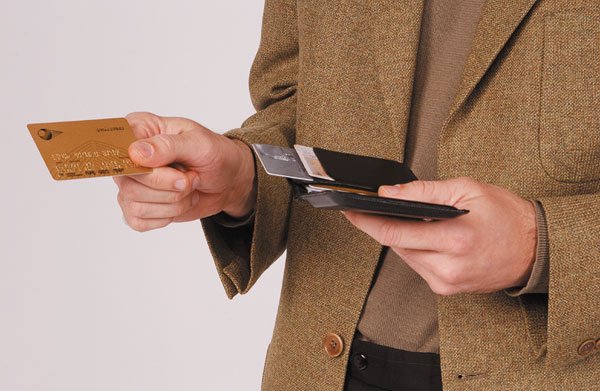en the Croy family’s income shrunk by half, they saw only one
way out
– strict, penny-pinching frugality. Their goal:
”
Get out of debt and reduce overhead, then grow as the economy
gets better,
”
said Chris Croy. Croy and his wife, Dina, took an ax to their
grocery list, killing all but necessities.
When the Croy family’s income shrunk by half, they saw only one way out – strict, penny-pinching frugality. Their goal: “Get out of debt and reduce overhead, then grow as the economy gets better,” said Chris Croy. Croy and his wife, Dina, took an ax to their grocery list, killing all but necessities.
They made their own baby wipes killing all but necessities. They made their own baby food and also made baby wipes (out of paper towels, baby oil, soap and water). They used leftover chicken bones to make soup.
They cut out their weekly lunch after church.
When their four young children imagined a trip to Disney World, Chris Croy pointed to the family budget on the refrigerator door. The money’s not there, he said.
Now they’re putting their 4,000-square-foot home in south St. Louis County on sale. They’ll dump their expensive mortgage and move to a rented house less than half the size in Imperial, Mo.
And the couple are selling the furniture they’ll no longer need in their downsized lives. “We’re actually quite enjoying the experience of purging so much stuff,” Croy said. “It looks like we’ll cut 70 percent off our cost of living.”
There’s a lot of that going on these days. After a binge of borrowing in the last decade, Americans have discovered thrift.
And that, unfortunately, is one of the major factors stalling the economic recovery.
The great debt pay-down is well under way. Consumers started the last decade about $5.2 trillion in debt. That rose to $12.5 trillion just before the 2008 financial crash. As of March, that was down to $11.5 trillion.
Croy is a professional photographer, specializing in portraits and weddings. Times are bad. Not only did the economic slump reduce wedding budgets, but many newly unemployed people with photography hobbies started marketing their services.
Back before the crash, the Croys took a laid-back approach to family finances.
“We really didn’t have a budget, because the cash flow was fine. We weren’t frivolous, and we also weren’t frugal. We’ve learned that frugality is an acquired taste.”
As for denied dreams of Disney World, the Croys will make it up by spending more time with their children. “Making life enjoyable for children is really not expensive. We play with them, take them to the park,” Croy said.
Unemployment was at 9.1 percent nationally in July. But for those who kept working, family balance sheets are improving.
Consumer bankruptcies were down 18 percent in July from a year earlier, continuing a series of declines that began this year, the American Bankruptcy Institute reported.
As of March, delinquencies on auto loans are at the lowest rate since the credit agency TransUnion began tracking them in 1999. Credit card delinquencies were their lowest since 1996.
Debt levels per credit-card borrower dropped 5.8 percent in the first quarter to $4,679, the lowest since 2000. Some claim that the drop in debt comes mainly from defaults, but TransUnion says it’s mainly consumers’ paying off debt. Consumers paid $72 billion more than they borrowed on their cards in 2009 and 2010.
If anything, Americans are getting thriftier. Consumer spending slid 0.2 percent in June, the biggest drop since September 2009, after a tiny a 0.1 percent increase in May. “That’s not necessarily a sign of something good,” said Howard Wall, a former Federal Reserve economist who now directs the Institute for Study of Economics and the Environment at Lindenwood University in St. Charles, Mo.
Consumers power 70 percent of the economy. Their newfound thrift is an economic ball and chain.
With the 2009 economic stimulus running dry, and Congress in a budget-cutting mood, there will be no burst of spending from Washington to make up for consumer cheapness.
That produces a chicken-and-egg dilemma, notes Wall. Consumers won’t spend while they’re worried about their jobs and pressed by higher prices for food and gasoline. But employers won’t hire until they see more demand for their goods and services, and most of that has to come from consumers.
Economists call that “the paradox of thrift.”
That high unemployment rate is a powerful motivation to save. Just ask Leonard Bell Jr.
Bell’s employer forced him to take an unpaid furlough week in 2009, and another in 2010. It was a shock to Bell, a single man from north St. Louis who had felt secure in his job as an auditor.
“Those furloughs made me take things more seriously,” he said. “Every week, I was writing out checks. … I thought, ‘Can I get to saving some?’ ”
So he launched his own austerity plan. “The crucial thing I did was stop using my credit cards,” he said. “I cook my own food. I didn’t go out a lot. I brought my lunch. I look for sales on shoes, sales on tires.”
He has paid off his car loan and now saves $300 a month.
He’s not alone. Families saved 5.4 percent of their income in June, the highest level in nearly a year and up from nearly zero before the recession, according to federal figures.
If they keep saving and cutting debt, consumers will eventually feel comfortable buying again. And that could give the economy a long-awaited boost.
Paul and Alexandra Charsley are at that point now.
Before the Great Recession, the couple were living in Affton, Mo., and running a coffee shop. They had borrowed $85,000, hoping the shop would be their key to financial security.
But in the depths of the slump in 2009, the shop was losing money. That’s when Paul was offered a job in Sonoma. “It was a good job, with benefits,” said Alexandra.
Wife, husband and two small children packed up and left. They sold their home of 12 years, and used the profit to pay down debt. But they still owed $35,000.
“We knew that load was huge,” Alexandra said. So they went on a strict financial diet. They have rented a home instead of buying. “We just cut out a lot of silly expenses,” she said.
That has meant no vacation for two years and no restaurant meals.
The lack of travel money has left them lonely for family back in St. Louis.
But they paid their debt down by $15,000 on their first year, and a steady paycheck is boosting their confidence.
“Now we’re seeing the light at the end of the tunnel, and we feel we have a little room,” Alexandra said. They’re finally replacing their old living room couch, and they’re planning to shop for a house in California.
Still, Gary Thayer, an economist and chief macro strategist at Wells Fargo Advisors, doesn’t think consumers are anywhere close to splurging on luxuries.
“They’re spending. They’re just spending cautiously, and we’re not at the point where they’re going to spend frivolously,” Thayer said. “I don’t think we can say we’re finished with this.”
The falling price of their homes – consumers’ biggest asset – still weighs on their psyche. They won’t spend freely again until housing prices start to recover, Thayer says.
Housing prices have risen slightly for three months in a row as of June, according to CoreLogic. But prices in June were still 6.8 percent below a year earlier.
American families’ total liabilities – mortgage, credit cards, car loans, the works – now amount to 119 percent of their annual income. That’s down from 136 percent in mid-2007, just before the recession struck.
The debt paydown has been rapid, but it’s not enough, says Bill O’Grady, chief market strategist at Confluence Investment Management in Webster Groves.
Back in 2000, before the country’s spending spree, family debt equaled 97 percent of income. O’Grady suspects that debt may have to return near there before consumers whip out their credit cards again.
“We don’t know where that magic level is,” he said.














